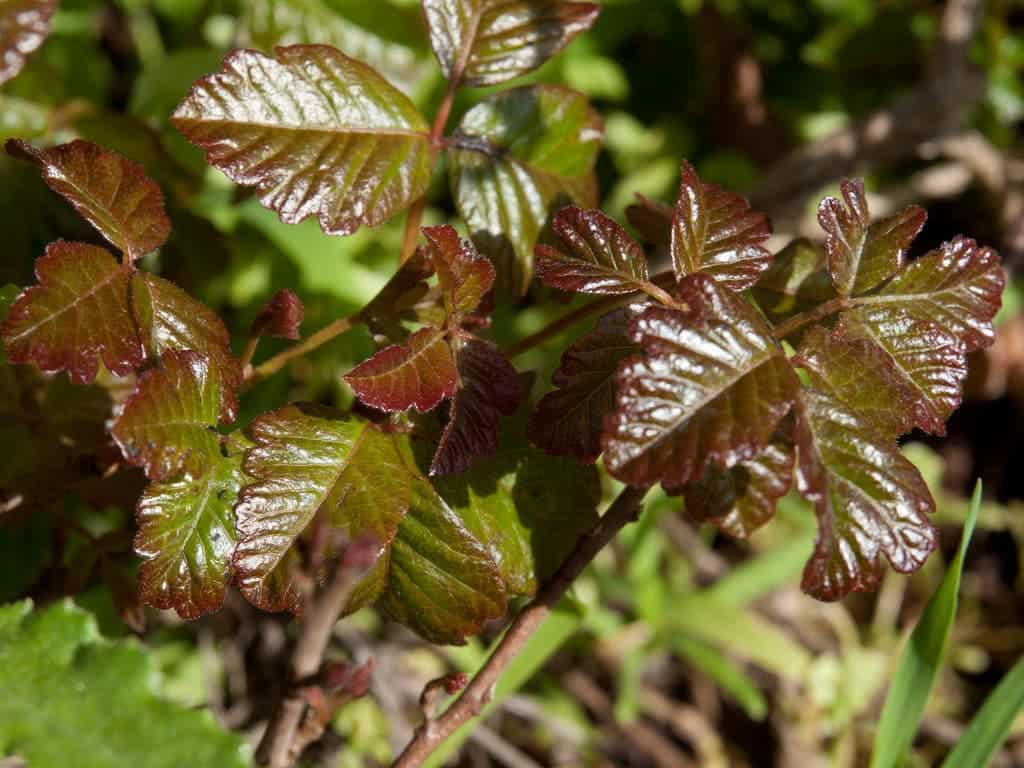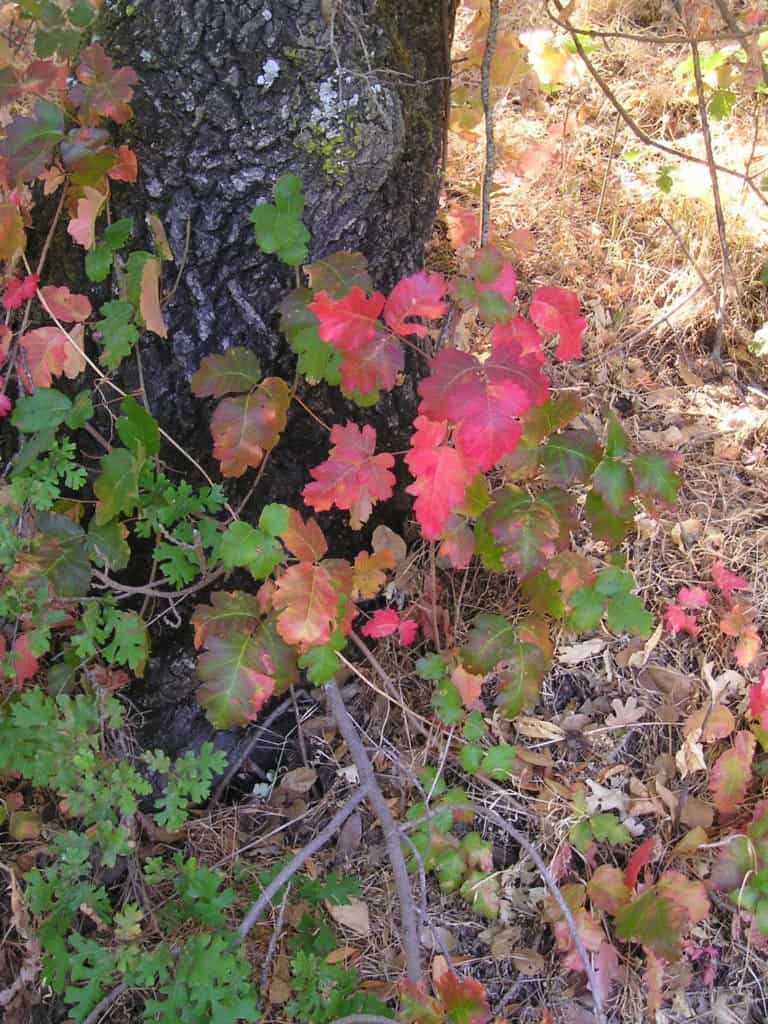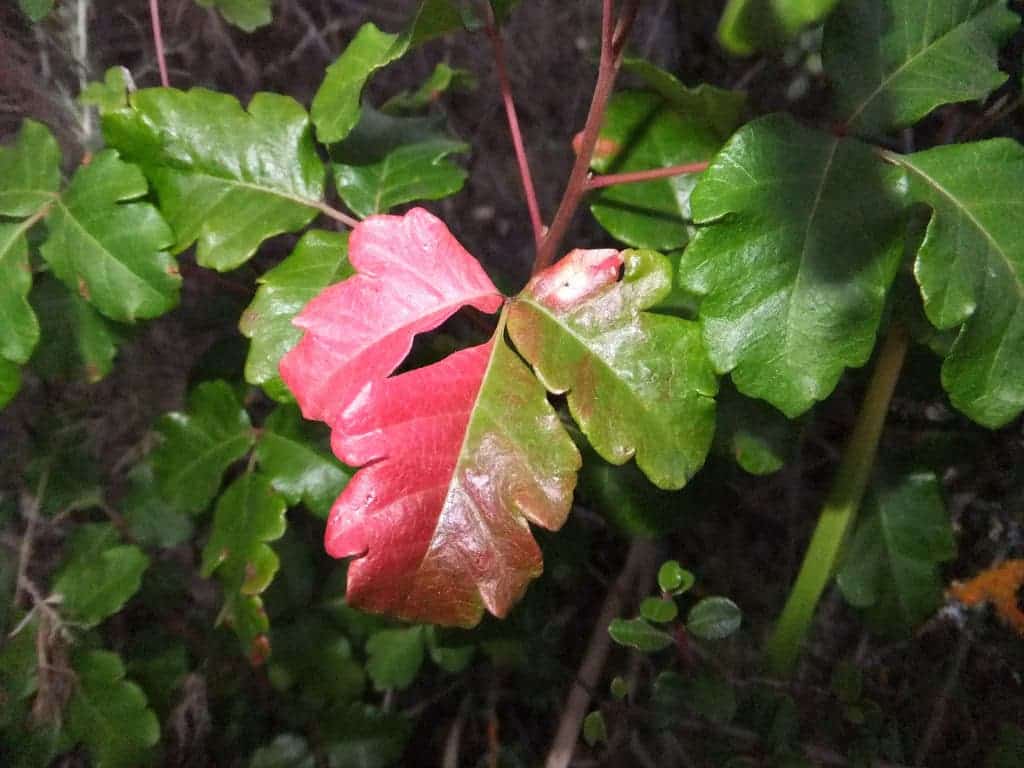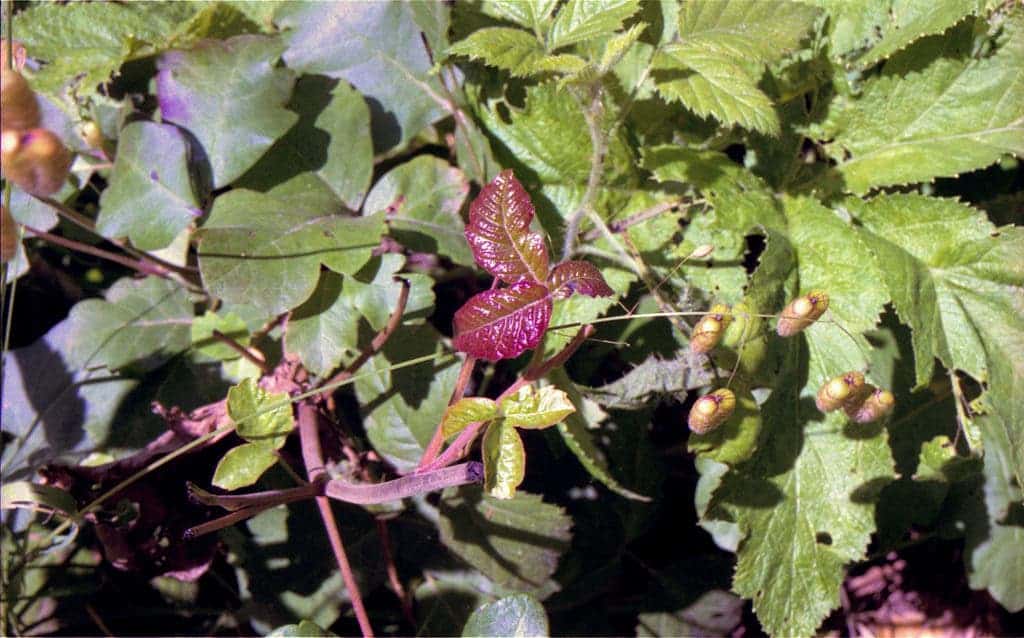Poison oak (Toxicodendron diversilobum) is a shrub widely distributed in North America, appearing in all sorts of forests and even some grasslands. It can give you a nasty rash if you touch it. We’re gonna have a look at what the plant looks like, why it gives you the rash, and what to do if you do get it.
What does Poison Oak look like?

The old saying holds true here. Just like poison ivy, poison oak’s leaves grow in threes — it’s not a definitive ID tip, but it’s a good starting point.
The plant looks like a leafy shrub, which it is. Despite the name, it’s not an oak, though its leaves look a bit like those of an oak (hence the reason for the name). Peak flowering occurs around May, and you might see it in pretty much every environment you can imagine, in both urban and rural areas — it just grows everywhere! It thrives in shady conditions, especially with alternating light. It can grow to impressive sizes (up to 30 m / 100 feet), climb up trees or other objects, and sometimes it kills the supporting plant by smothering it or simply collapsing it. Yes, poison oak is pretty much a jerk.
Renowned botanist John Howell observed that the toxicity of T. diversilobum obscures any other merit the plan might have.
“In spring, the ivory flowers bloom on the sunny hill or in sheltered glade, in summer its fine green leaves contrast refreshingly with dried and tawny grassland, in autumn its colors flame more brilliantly than in any other native, but one great fault, its poisonous juice, nullifies its every other virtue and renders this beautiful shrub the most disparaged of all within our region.”
How to identify Poison Oak
If you want to identify poison oak, the best thing you can do is to look at the leaves, which is why we’ll be going extra on the photos. It’s important to note that in some rare cases, the leaves can look quite different, and can even feature 5, 7, or even 9 leaflets.
The leaflets are typically 3.5 to 10 centimeters (1.4 to 3.9 in) long, with scalloped, toothed, or lobed edges. If you can recognize oak leaves, you’ll probably have a fairly easy time recognizing poison oak leaves. The main difference is that the latter’s leaves are almost always glossier. In February and March, the leaves are a shade of bronze, while in the early and mid-summer, they turn green; this is also when they grow their berries. At the end of summer and early into the autumn, leaves turn red and orange. It might even be a pleasant sight but again, you shouldn’t go touch it.
The plant produces small white, yellow, or green flowers. Leaves fall during the winter, and the plant can be pretty difficult to identify in that period — though the twigs can still sting you. If you look closely, you will probably be able to see some black marks where its milky sap may have oozed and dried.
Why Poison Oak hurts, and what to do if touch it
We’ve spoken a lot about how the plant looks like, but not a lot about why we should keep away from it.
Like poison ivy, poison sumac, and some parts of the mango tree, the poison oak’s leaves and trees have a surface oil called urushiol. Urushiol causes an allergic reaction which causes contact dermatitis and inflammation of varying severity. Not everyone is vulnerable to this, however. According to the University of California Agriculture & Natural Resources, only about 15 to 20 percent of people aren’t allergic to poison oak. But after enough exposure, everyone will become vulnerable. Here’s how urushiol works:
Both the leaves and the wooden part contain urushiol. If you touch it, you’ll first start to feel a slight itching. As the itching becomes stronger and stronger, it will evolve into dermatitis and inflammation. In the final stage, blisters emerge, accompanied by a lot of pain.
If you do get stung, the best thing you can do is wash your hands (or whatever body part you touched it with) with soap and water. Time is of the essence, as 50% of the urushiol can be absorbed within 10 minutes, and that’s enough to do a lot of damage. After it gets absorbed into the skin, there’s not much you can do except let it take its course.
Something else that’s important is…
Don’t burn the plant!!!
Remember how the inflammation and blisters can appear on your skin? Well, urushiol volatilizes when burned, so imagine all that pain happening on the inside of your nose, your trachea, and your lungs. Seriously, poison oak smoke can be very unpleasant and dangerous, as unknowing campers who used twigs for their fires have learned.
Other facts about Poison Oak
Interestingly, not all creatures suffer this reaction. Many animals are not only not allergic to poison oak, but they feed on it. So you might see deer and squirrels chowing down on poison oak, but that doesn’t mean it’s safe to touch. It is rich in phosphorus, calcium, and sulfur, which makes it quite attractive for herbivores. Native North American animals (including dogs and horses) don’t seem to have an allergic reaction of any sort. Birds eat the berries and pick the rest of the plant to build nests.
Humans generally tend to eliminate the plant as soon as they see it (though again, burning is not a solution). You’ll find pesticides specifically tailored for it, and it’s regarded as a weed no matter where it pops up. But it doesn’t mean that the plant is completely useless.
Californian Native Americans carefully picked the planet and let it dry, after which they made baskets from the stems and shoots. They believed the plant could cure or treat several ailments; they used the sap to cure ringworm and as a poultice of fresh leaves applied to rattlesnake bites, the sap to remove warts, corns, and calluses, to cauterize sores, and to stop bleeding. However, I couldn’t find any scientific or medical reference to any of these practices, so I strongly recommend against them.
In more modern times, T. diversilobum is used in habitat restoration projects, especially in former forests that have been completely burned down or destroyed. Poison oak can grow in rough environments and can sometimes serve as a nurse plant for other species — facilitating their growth. Huh, after all, turns out poison oak isn’t such a jerk after all. As long as you don’t touch it.






